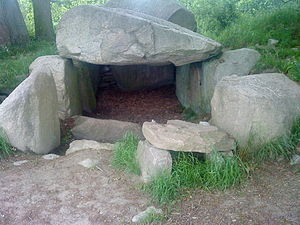A dolmen, also known as a portal tomb, portal grave, or quoit, is a type of single-chamber megalithic tomb, usually consisting of three or more upright stones supporting a large flat horizontal capstone (table), although there are also more complex variants. Most date from the early Neolithic period (4000 to 3000 BC). Dolmens were usually covered with earth or smaller stones to form a barrow, though in many cases that covering has weathered away, leaving only the stone "skeleton" of the burial mound intact.
It remains unclear when, why, and by whom the earliest dolmens were made. The oldest known dolmens are in Western Europe, where they were set in place around 7000 years ago, at the same time as the ancient civilisations of Egypt, India, and the Middle East. Archaeologists still do not know who erected these dolmens, which makes it difficult to know why they did it. The most widely accepted theory is that all dolmens are tombs or burial chambers. Human remains, sometimes accompanied by artifacts, have been found in or close to them, which could be scientifically dated. There is however no firm evidence that even this theory is correct. It has been impossible to prove that these archaeological remains date from the time when the stones were set in place.
Dolmen sites
Asia
Korea
The largest concentration of dolmen in the world is found on the Korean peninsula. With an estimated 35,000 dolmen, Korea alone accounts for nearly 40% of the world’s total.The largest distribution of these is on the west coast area of South Korea.
Three specific UNESCO World Heritage sites at Gochang, Hwasun and Ganghwa by themselves account for over 1,000 dolmen.
The Korean word for dolmen is goindol (hangul:고인돌). Serious studies of the Korean megalithic monuments were not undertaken until relatively recently, well after much research had already been conducted on dolmen in other regions of the world. After 1945, new research is being conducted by Korean scholars.
Korean dolmen exhibit a morphology distinct from the Atlantic European dolmen.
In 1981 a curator of Seoul's National Museum of Korea, Gon-Gil Ji, classified Korean dolmen into two general types: northern and southern. The boundary between them falls at the Bukhan River although examples of both types are found on either side. Northern style dolmens stand above ground with a four sided chamber and a megalithic roof (also referred to as "table type"), while southern style dolmens are normally built into the ground and contain a stone chest or pit covered by a rock slab.
Korean dolmen can also be divided into 3 main types: the table type, the go-table type and the unsupported capstone type. The dolmen in Ganghwa is a northern-type, table-shaped dolmen and is the biggest stone of this kind in South Korea, measuring 2.6 by 7.1 by 5.5 metres. There are many sub-types and different styles. Southern type dolmen are associated with burials but the reason for building northern style dolmen is uncertain.
Due to the vast numbers and great variation in styles, no absolute chronology of Korean dolmen has yet been established. It is generally accepted that the Korean megalithic culture emerged from the late Neolithic age, during which agriculture developed on the peninsula, and flourished throughout the Bronze Age. Thus, it is estimated that the Korean dolmen were built in the first millennium BC.
How and why Korea has produced so many dolmen are still poorly understood. There is no current conclusive theory on the origin of Korea's megalithic culture, and so it is difficult to determine the true cultural character of Korean dolmen. A few northern style dolmens are found in Manchuria and the Shandong Peninsula. Off the peninsula, similar specimens can be found in smaller numbers, but they are often considerably larger than the Korean dolmen.
It is a mystery as to factors caused this culture to flourish so extensively only on the Korean peninsula and its vicinity in Northeast Asia.



댓글 없음:
댓글 쓰기